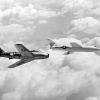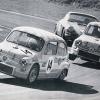The strange dichotomy of BRM and Bonnier
#1

Posted 09 April 2010 - 12:22
Over the years following the V16, the 4 cylinder BRM variously enjoyed the world's best drivers, roughly, in order, Hawthorn, Brooks, Salvadori, Flockhart, Schell, Behra and in 1959 even Moss, but strangely,despite being very fast, the only race of significance the car ever won, was the 1959 Dutch GP, at the hands of Jo Bonnier.
In early 1958 , Bonnier was a stand-out in the out-moded 250F Maserati, easily out-shining Gregory and Shelby etal and at BRM late in 1958 , he was qjicker than Schell and Behra.
At Zandvoort 1959, both the car and driver, reached heights that neither would ever achieve again.
Bonnier, in 1960, was over-shadowed by G Hill and Gurney at BRM, but in 1961, both he and Gurney were able to take the fightt to Ferrari...thereafter, Bonnier it seems, descended via Rob Walker Coopers, to a journeyman level.
My questions are therefore :
Was the post-V16 BRM an unlucky car and did it deserve more victories?
Why did Jo Bonnier seemingly sparkle and then decline ?"
JB
Advertisement
#2

Posted 10 April 2010 - 02:13
#3

Posted 10 April 2010 - 07:37
Sports cars, on the other hand, were an entirely different matter; he could be a real tiger, right up until his death in 1972. I seem to remember him going very well in a Lola T70 and, at the BOAC 1000 in 1972, he, Craft and Wisell all took the fight to the Ferraris driving Eric Broadley's rapid 3 litre cars. I might be wrong, he may not have been that quick, someone will know. What is certain though is the speed and fight he showed at Spa in 1970 or 1971, battling for lap after lap with Brian Redman for the 2 litre sports car championship, Brian in a Chevron, Jo in a Lola, a race only decided at the final corner after a high speed, race long struggle. I realise that 2 litre sports cars are not GP cars but flat out, against Redman at the old Spa? Bonnier was obviously no slouch. I'm looking forward to hearing more from others more knowledgeable, or closer to the action.
Edited by john winfield, 10 April 2010 - 07:39.
#4

Posted 10 April 2010 - 08:08
The engine was powerful but the enormous valves, sodium-filled, used to cause trouble with heads falling off. Then there was the trouble with the driveshaft pot joints which gave Mike Hawthorn a very nasty fright.
Just a short introduction as I do not have my books to hand; there are numerous experts hereabouts who will complete this.
Paul
Edited by VAR1016, 10 April 2010 - 08:09.
#5

Posted 10 April 2010 - 08:13
I too have often wondered what went wrong with Bonnier. I've just had a quick flick through the 1960 grid times, and here Bonnier was at least a match for Hill and Gurney (and led the races in Argentina and Monaco). The same in 1961 - Bonnier and Gurney very evenly matched. The decline seemed to start in 1962, where Gurney dominated him in qualifying, and from then on it seemed to be downhill all the way.Bonnier, in 1960, was over-shadowed by G Hill and Gurney at BRM ...
#6

Posted 10 April 2010 - 08:23
Moss has decribed the P25 as the best handling front-engined Grand Prix car he ever drove. I think the reasons for its failure lay in poor preparation and lack of attention to detail. Brakes would fail, sometimes seizing on, sometimes off. Engines would lose power for no apparent reason. It seems to fit the dilletante image of Mays and Berthon, the team principals of the time. It's ironic because they had on the staff an engineer whose engineering thoroughness and attention to detail was unrivalled in British motor racing at the time. Success came when Tony Rudd was given full control.
As regards Bonnier, it's unfair to say that he was overshadowed by his team mates in 1960. In the first half of the season he was usually fastest although there was admittedly a relative decine after Reims. He was Gurney's equal in 1961 but seemd to lose interest in Grand Prix racing in 1962. When the Porsche 804 first appeared it had a lot of problems; some at Porsche wanted to withdraw. It was Gurney who pushed to keep racing and developing and Bonnier never really recovered.
#7

Posted 10 April 2010 - 09:34
#8

Posted 10 April 2010 - 09:36
There is a very good book, written by somebody called Nye, that will tell you everything you ever wanted to know about the P25 BRM and a lot more besides.
Moss has decribed the P25 as the best handling front-engined Grand Prix car he ever drove. I think the reasons for its failure lay in poor preparation and lack of attention to detail. Brakes would fail, sometimes seizing on, sometimes off. Engines would lose power for no apparent reason. It seems to fit the dilletante image of Mays and Berthon, the team principals of the time. It's ironic because they had on the staff an engineer whose engineering thoroughness and attention to detail was unrivalled in British motor racing at the time. Success came when Tony Rudd was given full control.
As regards Bonnier, it's unfair to say that he was overshadowed by his team mates in 1960. In the first half of the season he was usually fastest although there was admittedly a relative decine after Reims. He was Gurney's equal in 1961 but seemd to lose interest in Grand Prix racing in 1962. When the Porsche 804 first appeared it had a lot of problems; some at Porsche wanted to withdraw. It was Gurney who pushed to keep racing and developing and Bonnier never really recovered.
Yes, that's one of the books I do not have here - similarly "It Was Fun" by Tony Rudd. As you say it was Rudd who put BRM on the road to success - just in time! Incidentally I recall that a V6 was considered for the 2.5 litre car; another fascinating "might-have-been"
#9

Posted 10 April 2010 - 09:47
Did he lose his motivation when "relegated" to a non-works team, and realising he was unlikely to win another GP? Or was it a sort of semi-retirement, happy to take a back seat, continue in racing at the top level, and enjoy the Grand Prix life?
There definitely seems to have been a pronounced and quite sudden drop in his competitiveness in F1 from that point
#10

Posted 10 April 2010 - 09:54

By giraffe138, shot with EX-M2 at 2009-11-13
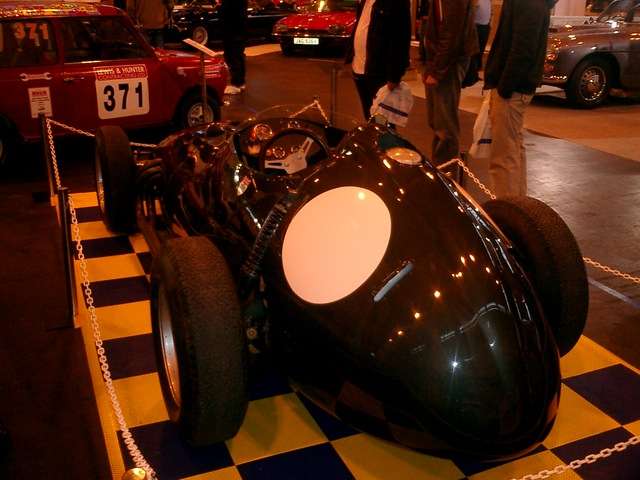
By giraffe138, shot with EX-M2 at 2009-11-13
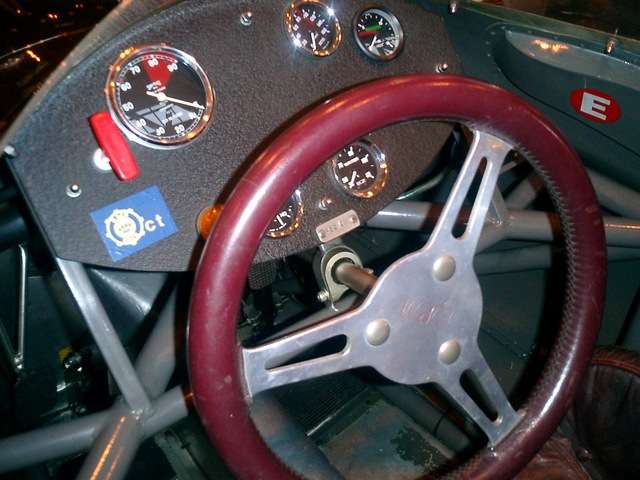
By giraffe138, shot with EX-M2 at 2009-11-13
P25 - 9R on the Owen Motor Club stand at the Classic Car Show in Birmingham earlier this year.

By giraffe138 at 2010-01-06
Jo Bonnier chatting to Sid Taylor at the Oulton Park Tourist Trophy, May 1969.
#11

Posted 10 April 2010 - 10:00
Agree that Bonnier was still very much on the pace in early 1960, and 1961
Did he lose his motivation when "relegated" to a non-works team, and realising he was unlikely to win another GP? Or was it a sort of semi-retirement, happy to take a back seat, continue in racing at the top level, and enjoy the Grand Prix life?
There definitely seems to have been a pronounced and quite sudden drop in his competitiveness in F1 from that point
Could the death of his father (in January 1961) have eventually caused him to become less motivated. Was he required to play a greater part in upholding the family name and fortune?
#12

Posted 10 April 2010 - 10:06
#13

Posted 10 April 2010 - 10:15
He bacame a father in April 1962, this could have had something to do with it. The boy was called Joachim-Wolfgang, after von Trips.
#14

Posted 10 April 2010 - 10:58
Perhaps Jo just could not get comfortable in the tiny 1,5L F1 cars in the sixties.
Edited by Rob Miller, 10 April 2010 - 14:22.
#15

Posted 10 April 2010 - 13:14
Copyright??????
GPL, thank you - or at least we have a neg suspiciously similar, taken by Geoff Goddard at Clermont-Ferrand.
The BRM Type 25 should perhaps have been at least the equal of the V6 Ferraris in 1958-59 but for the pettyfogging reasons cited by Roger above. What really did not help one little bit in 1958 was Behra's temperament, although his flounces were at least understandable - if not forgivable - considering his experience in the Goodwood chicane on Easter Monday, and entering the Masta Kink at Spa during practice for the Belgian GP.
By 1959 the Type 25 and its P25 engine had been sorted out with the correct number of main bearings enabling its optimum power to be released, rather than turned into rejected heat. But by then it had to contend with a V6 Ferrari which demonstrably put down more power, and which had in essence similarly-effective disc brakes - though one more than BRM - but which was rather heavier.
Jo Bonnier was, however, no driving match for Ferrari's finest led by Tony Brooks, nor - in particular - for the combinations of Brabham/works Cooper and Moss/Walker Cooper. Had those three been taken out of the equation, Bonnier and Schell and Flockhart might have achieved better results in the Type 25s. Yeah but...
JoBo was always something of an enigma. He was a strangely remote character to the many, a loyal and warm friend to a few - such as Graham Hill. He was a good second-string racing driver on his best days, when he felt he was in with a strong chance, and he was particularly prepared to mix it in sports cars, rather than in open wheelers. Once he became President of the GPDA his linguistic skills shone and he was very effective, but he seemed to continue by merely going through the motions in Formula 1 post-Walker 1963-65. I don't think he was particularly a paragon of virtue. He wheeled and dealed with the best as Lola's European agent, he did very well thank you out of Hollywood film companies for whom he provided cars and occasionally drivers, and the many owner-drivers racing against him in the Nordic Cup developed dark opinions about what size engine he was running in his nominally 5-litre Lola! But he certainly became a most effective long-distance driver, and his fatal accident at Le Mans occurred when he was really on it, and trying perhaps too hard. Perhaps it's fairer to say that poor JoBo was simply one of those ultimately really unlucky drivers who ended up arriving at the wrong place, at the wrong time. He certainly did not deserve the catastrophic fate which befell him, poor chap.
DCN
Edited by Doug Nye, 10 April 2010 - 13:15.
#16

Posted 10 April 2010 - 13:15
IIRC Jo Bonnier had money, which meant he possibly went motor racing because it interested him and he could, not neccessarily driving forces. The will to win is paramount in any sport, maybe Bonnier didn't have enough of it.
Edited by Bloggsworth, 10 April 2010 - 13:16.
#17

Posted 10 April 2010 - 13:51
A shame he didn't survive another twenty years to tell his grandchildren why he did it.
#18

Posted 10 April 2010 - 14:48
That he used his McLaren BRM as a living room wall ornament speaks volumes about him...
A shame he didn't survive another twenty years to tell his grandchildren why he did it.
I thought that was his beautiful Lola sports car. Mind you, if I were rich I'd have an Aston Martin DB7 on my wall....
#19

Posted 10 April 2010 - 15:45
Advertisement
#20

Posted 10 April 2010 - 16:41
BRM P25 my favourite car of all time - I still have my ORMA membership card, and remember dancing around the school when Bonnier won that race. The P25 had won a couple of non-championship GP's in 1958, Caen and ??? in the Hands of Jean Behra, one of them in a 1-2 with Harry Schell (There were only 6 to 10 championship races in those days).
I am a little surprised that a fellow O.R.M.A member could be so vague about the Behra-Schell-Flockhart 1-2-3 finish in the 1957 International Trophy Race (after winning the heats as well). I recall that Jo Bonnier was considered to be a good second division driver at that time, but pretty useful on his day, and I was glad to see him driving for BRM in the 1957 Modena Grand Prix after Mr Vandervell had refused to release his driver Stuart Lewis-Evans. I too was thrilled when I heard that Jo had won at Zandvoort, although I had previously hoped that it might have been Mike Hawthorn or Jean Behra who scored BRM's first Championship race win. The B RM P.25 seemed well suited to the Dutch circuit as they had finished second and third there the previous year. Incidentally, the first time that I saw Jo Bonnier race he was driving a Volvo in a Silverstone touring car race!.
#21

Posted 10 April 2010 - 17:04
#22

Posted 10 April 2010 - 19:35
...I were rich I'd have an Aston Martin DB7 on my wall....
And, if I were very rich, I'd have Max Mosley buried underneath my patio. It would give me some satisfaction, but I'd know that I had the gratitude of motor racing fans all over the world.
#23

Posted 10 April 2010 - 23:02
1959?An F2 Porsche in the Kentish 100 at Brands in 1957 was my first sight of everybody in the top echelon apart from Fangio and Hawthorn.
#24

Posted 10 April 2010 - 23:15
#25

Posted 11 April 2010 - 05:57
In early 1958 , Bonnier was a stand-out in the out-moded 250F Maserati, easily out-shining Gregory and Shelby etal and at BRM late in 1958 , he was qjicker than Schell and Behra.
Bonnier was a great driver, but, respectfully, I don't think this assessment of his 1958 season is correct. At least in qualifying...
- in Maseratis: Monaco, behind Scarlatti; Zandvoort and Spa, behind Gregory; at Rheims, behind Godia and Gerini (and Fangio); at Oporto, behind Shelby and Allison; his was the fastest Maserati at Silverstone and Nurburgring
- in BRM; at Monza, behind Behra and Schell; at Casablanca, behind Behra
Vince H.
#26

Posted 11 April 2010 - 06:26
Obviously 58 latest if you saw Lewis-Evans but no Porsches until 59Stuart Lewis Evans was there, so not '59, I'm pretty sure it was a silver F2 Porsche...
#27

Posted 11 April 2010 - 07:08
Porsche did return for the same race in 1960 but were definitely not there before 1959.
#28

Posted 11 April 2010 - 07:17
But JoBo, as the others say, didn't get there -with the Porsche - till the 1959 edition
#29

Posted 11 April 2010 - 10:05
I recall Moss in the Rob Walker Porsche with the cigar-wrapper stripe round the nose, but that must have been '60, as he drove a Cooper-Borgward in '59; and Carel Godine de Beaufort in an orange one, clearly the years are melding in the memory.
Edited by Bloggsworth, 11 April 2010 - 10:05.
#30

Posted 11 April 2010 - 10:48
#31

Posted 11 April 2010 - 12:44
#32

Posted 11 April 2010 - 14:26
True, since the 1961 Dutch GP he started to drive the 718.I don't think de Beaufort raced a Porsche 718 until 1961
#33

Posted 12 April 2010 - 08:00
#34

Posted 12 April 2010 - 09:49
I would be very interested in the comparison of lap times between Jo and Surtees during that race. Autocourses out, chaps.
#35

Posted 12 April 2010 - 10:37
His lap times laps 2 to 8 were 1 50.87, 1.50.21, 1 50.11, 1 50.71, 1 49.27, 1 49.67, 1 49.60.
Bonnier recorded 1 53.68, 1 52.40, 1 52.28, 1 52.06, 1 52.02, 1 51.49, 1 51.77.
Bonnier qualifed 18th and finished 5th, without overtaking anyone except as a result of their mechanical failure. His fastest lap was 1 46.78 on lap 60 of 65, but that was the only time he broke 1 47s.
#36

Posted 12 April 2010 - 11:13
Edited by Tim Murray, 12 April 2010 - 11:15.
#37

Posted 12 April 2010 - 11:30
#38

Posted 12 April 2010 - 12:02
No, Barry. His practice time was 1 49.96 in the Honda. He managed 1 52.30 the previous day in his McLaren.I am not sure that Jo drove the car AT ALL before the race. His grid time was, apparently, achieved with the McLaren.
#39

Posted 12 April 2010 - 12:46
As an aside I recall Michael Cooper telling me that Bonnier was not very popular with the photographers for reasons I can no longer recall, possibly his demeanour.
Advertisement
#40

Posted 12 April 2010 - 12:47
As to what Paul mentioned, I could never envisage Bonnier having the nickname 'Smiler' unless it was used in the same way as Australians call people 'Blue'.
Edited by Barry Boor, 12 April 2010 - 12:55.
#41

Posted 12 April 2010 - 14:24
As an aside I recall Michael Cooper telling me that Bonnier was not very popular with the photographers for reasons I can no longer recall, possibly his demeanour.
Although I saw him race several times, I never had any contact with Jo Bonnier. I've been with a few people who knew or worked with him though, mostly at Lola, and one word that I think every single one of them used was 'aloof', so that's probably as good guide to his persona as we're going to get.
#42

Posted 12 April 2010 - 14:45
and one word that I think every single one of them used was 'aloof', so that's probably as good guide to his persona as we're going to get.
I have some 8mm movie footage I shot of Jo at Oulton Park. I pushed into a crowd to find Jo in the middle of it, sat in his rented Lada reading the newspaper! Around 100 people watched him read it from front to back, and not once did he raise his eyes from the page! (Oh, he signed a slip a mechanic passed through the gap at the top of the window!)
( You'd have difficulty getting that many people to Silverstone for a Superleague meeting today, but in 1969 they'd even pay to watch a driver read the newspaper!
Edited by Giraffe, 12 April 2010 - 14:47.
#43

Posted 13 April 2010 - 23:30
I over-stated Bonnier's 1958 achievements and under-stated his 1960 achievements.
However the fact that in 1959 he was more or less equal overall with Behra and Schell, both very experienced GP drivers and in 1960 and 1961, was equal to Hill and Gurney, I believe only emphasises my original point that he appeared to verging on, if not already in, the front rank . As somebody has pointed out, in 1960 he led some GP's for BRM and in 1961 at Porsche, he was certainly as fast as Gurney. Syracuse, Rheims and I think Solitude of that year spring to mind readily.
He was still a quick privateer for Rob Walker in 1963 in the fast becoming out-moded Coopers, but by 1966 and in his private Cooper Maserat, he was certainly pretty "ordinary" - as aussies like to say.
I can understand a driver turning up for the sake of it if he is driving someboy else's car, but to go to all the cost and trouble of running your own car and team only to run around at the back of the field mystifies me.
As has been pointed out, he could run with the best in sports cars right till the end and this only serves to further highlight the strangeness of the decline in his GP career.
Maybe as suggested by some people, his personality was such, that if he didnt have a drive which matched his own estimation of his status, he simply "coiuldn't be bothered"
If so, why bother at all?
Interesting
JB
#44

Posted 16 April 2010 - 12:13
I have some 8mm movie footage I shot of Jo at Oulton Park. I pushed into a crowd to find Jo in the middle of it, sat in his rented Lada reading the newspaper! Around 100 people watched him read it from front to back, and not once did he raise his eyes from the page! (Oh, he signed a slip a mechanic passed through the gap at the top of the window!)
( You'd have difficulty getting that many people to Silverstone for a Superleague meeting today, but in 1969 they'd even pay to watch a driver read the newspaper!)

By giraffe138, shot with EX-M2 at 2010-04-16
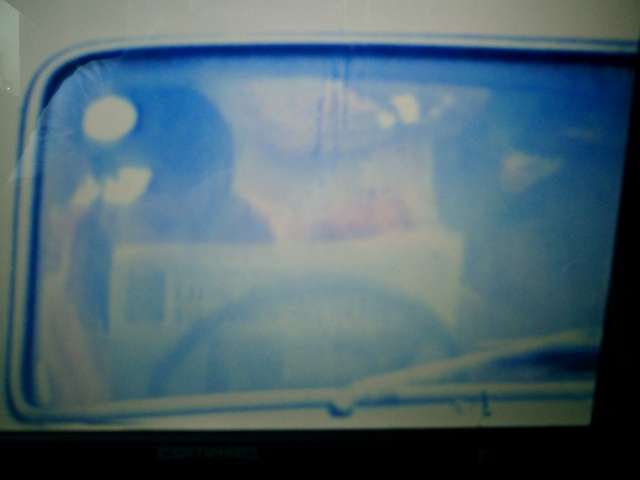
By giraffe138, shot with EX-M2 at 2010-04-16

By giraffe138, shot with EX-M2 at 2010-04-16
#45

Posted 16 April 2010 - 12:44
http://archives.tsr....r/siffert-clark
#46

Posted 16 April 2010 - 15:43
Although I saw him race several times, I never had any contact with Jo Bonnier. I've been with a few people who knew or worked with him though, mostly at Lola, and one word that I think every single one of them used was 'aloof', so that's probably as good guide to his persona as we're going to get.
This reminds me of one of Henry Manney's stories about Bonnier. At the time he was President of the GPDA there was some controversy going on and Bonnier was in conversation with an FIA notable when a photographer took his picture. Bonnier was furious, grabbed the camera and started an argument with the photographer.
Henry's remark on this incident was " ....this must be the first time in history Jo Bonnier refused to have his picture taken !!!" Aloof and slightly vain I may add.
#47

Posted 16 April 2010 - 17:22
IIRC Jo Bonnier had money, which meant he possibly went motor racing because it interested him and he could, not neccessarily driving forces. The will to win is paramount in any sport, maybe Bonnier didn't have enough of it.
Although Bonnier came from a wealthy family, he actually was a self-made man. His mother wanted him to be a doctor and others in his family tried to find a place for him in the media business. Instead he started as a car salesman. And it wasn't until he got the Alfa Romeo agency, that he realized that he was quite good at driving cars. In his first years as a racing driver he did like all the other stars in those days, raced everything, everywhere all the time.
Jo could well have won more World Championship races with a little bit more luck. The closest was probably Argentina 1960, where he led most of the race and held a one-lap lead when a valve-spring broke. A race strangely forgotten in British history books.
For 1961 he was considered as one of the World Championship candidates, but it was not to be.
There were several possible reasons for him losing his edge. His close friend Wolfgang von Trips was killed right in front of him at Monza '61, he became a father in '62 and he didn't get a factory contract for '63. Bonnier was probably not an easy driver for any team. He knew what he wanted and asked for it. After all he had run his own team before. It was a pity he died when he did. He was going to quit racing and concentrate on running his team. But he loved racing a bit too much.







